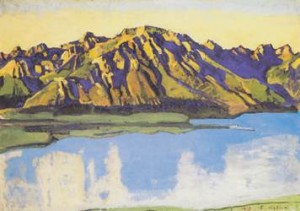Smokies, Bieszczady, Cevennes…(to Scenes # 16)
Since the first time I visited Great Smoky Mountains in North Carolina, I have always been under a great spell of these multiple rows of mountain ridges, one after another, until the horizon, and I could not stop counting them, finishing usually at 9, 10 or 11. You can count them yourself on the photos that I have taken on various occasions, and in different seasons and at different times of the day.
But then I have shown the first draft of my cut-out to a friend in Southern France, he exclaimed: these are Cevennes! Cevennes are a southern part of Massif Central. They are the same type of relatively low, “old mountains” as Appalachians, as opposed to fierce young mountains, like the Alps, Himalayas or Tatra, or the Rockies. I spent a week in Cevennes with my wife about 6-7 years ago, and we were enchanted, by the same “atmospheric charm”. I return there, when I can.

Les Cevennes , par “Mediations.fr.”
When I have shown my cut-out to my brother, he asked: are these Bieszczady ? Bieszczady are a part of eastern Carpathians at the Poland’s border with Ukraine, the same type of “old” mountains. I spent there weeks during treks alone, or with friends when I was in my late teens or in my twenties, attracted by their magie sauvage.

(Autor: siwypz; Source: National Geographic)
So, I think at this point you’ve got the message: all these mountains emanate the same kind of spell (that means the “old” ones).
Therefore, to make my Smokies distinct, I have embedded in the picture an animal, which does not exist in any European mountains, but is common in the Smokies: an opossum. It is rather helpless, nocturnal animal, with a bare, long, ratty tail and wobbly walk. It is not the cutest creature of the universe, but I love it. I made cut-outs of the opossums before (enclosed are two versions (one wild and another elegant) and a photo from our back-yard deck)

Opossum (didelphimorphia) on our deck
Mountains, in my opinion, did not have too much luck in paintings, with a few noble exceptions. There were plenty of mountain artists in the history, but most of them were dead-realists as nineteenth century Thomas Cole, or German/American Albert Bierstadt, and quite effective, I must say. Good for them.

Albert Bierstadt The Rocky Mountains, Lander’s Peak (1863), Metropolitan Museum of Art, New York City, NY
or Swiss Ferdinand Holder. The latter was capable of a more abstract/symbolic approach


Ferdinand Hodler: 1917, The Grammont Ferdinand Hodler: 1917, Dents du Midi in Clouds
The impressionists gave mountains more charm, incantation and perhaps awe as in Hans Berger, or Cezanne with his obsession about Mont Saint Victoire near Aix en Provence, contageing many others with it (American Marsden Hartley, among them), or in an idyllic Gauguin from Tahiti.

Paul Cezanne, 1902-4, Monte Saint Victoire

Marsden Hartley, 1925 Monte Saint Victoire (taken at Portland Museum of Art)

Hans BERGER, 1910, PROVENCE: Pines and Rocks –seen in Kunstmuseum Solothurn

Paul Gauguin, 1893, Tahitian Mountains
With expressionists it’s an entirely different story. Their mountains are just icons like for Kandinsky


Wassily Kandinsky, 1910 Mountain landscape with church, 1908 Autumn in Murnau
or a play of colors, like for Kirchner, namely with his preferred violet/purple. As much as I like Kirchner, I do not think he really cracked down the problem what to do with mountains, plastically.
Not that I know what to do with them…

Erich Ludwig Kirchner, 1922 Landschaft Sertigtal (from the wonderful Marzebacher collection)

Paul Klee, 1920, Petit Paysage Rythmique


Gabriele Münther, 1909, Staffelsselandschaft Gabriele Münther, 1936, Olympiastrasse bei Murnau mit Murnauer Moos und Kirche
However, the biggest stimulus for me was to see a small (like most of them) work by Paul Klee, Petit Paysage Rythmique. The form of the details of this piece seemed to me to be perfectly suited for my type of cut-out. But the main thing that attracted me to this composition is indeed its rhythm: of the repeated hedgegrows, of repeated yellow trees and green trees, and of what appears to be dandelions. So, the rhythm is what was the motivation. May be, one day I will try to do my version of the Klee’s paysage rythmique.
The next association for me was that of beautiful paintings by Gabriele Münther (see my story about Road to Murnau). Two of them (inserted above) are dominated by the rhythm of the mountain ridges. Now, you may say, the rhythm of the mountain ridges in the Smokies’ was in my case what I always wanted, but truly it came out of that whole story of little paysage rhythmique.
A revelation post factum finding was for me two early Georgia O’Keefe’s landscapes from Maine coast that I attach below. They are simple and stunning.


Georgia O’Keeffe, 1922. Sun Water Maine, 1922; Georgia O’Keeffe, 1923- Pink Moon Over Water
 T. Hueckel, In the Smokies, 2015
T. Hueckel, In the Smokies, 2015










Leave a Reply